All of London was off the tourist track for a couple of days recently, because it was the annual Open House London weekend. To quote their website:
Some of the site are very popular and require you to pre-book to hold a space when the program becomes available in early August. Because I was late to the party this year I was shut out of anything that required pre-booking, which meant my options narrowed a bit, though not a lot because as mentioned above, there were more than 700 sites. I eventually whittled down my choices and on a sunny Saturday morning I set out on the tube, leaving the bike behind to avoid a repeat of my continuing bike locking woes. I hit quite a few sites over the weekend because though I made certain plans I also stayed flexible, meaning that if I unexpectedly happened on the welcoming green Open House poster as I was on my way from point A to point B I was free to veer off to investigate point C. Some point Cs were places where I just poked my head in before deciding they weren't for me, and some were perfectly excellent. For the purposes of this blog post we shall concentrate on the excellent, glossing over the so-so. (There was, for instance, the archeological remains of the western gate of the Roman wall around the city, which were situated in a damp, locked, unmarked room that was part of an underground parking lot. That was only so-so, mostly because though the site was significant, there really wasn't much to see beyond a pile of rocks in the vague shape of a wall. Also, the whole place smelled of exhaust and gasoline. And there was the aforementioned Bank of England, which I skipped because the queue was around the block.) Instead, let's talk about a couple of the hits:
St. Botolph's Aldgate Bells and Belfry:
My first stop on that sunny Saturday morning was to see the bells and belfry of St. Botolph's without Aldgate church (as distinct from St. Botolph's Aldersgate church, which astute GSWPL readers will remember from my blog about Postman's Park). The Open House program promised a visit to the belfry itself and a demonstration of bell ringing, which it turns out is a lot more complicated than just yanking on a bit of rope.
I had to wait around a bit after I arrived because space in the bell ringing room was limited and demand was high. After a half hour wait, and armed with a numbered bit of paper for the 11:30am visit, I ascended the steep, narrow, winding circular stairs up to the ringing room to find a surprisingly comfortable, airy space dominated by eight ropes hanging down through holes in the ceiling.
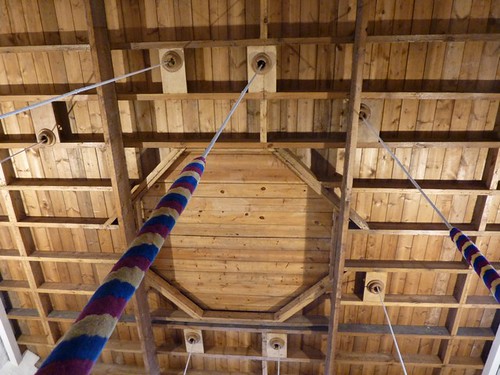
There was a gentleman there from the church's band of bell ringers who gave us some interesting facts about the bells and the craft. There are eight bells at St. Botolph's, which are normally rung in the change ringing style, meaning that a group of ringers will ring each bell in a sequence which changes as they go along. In order to be able to ring in such a controlled fashion, the bells are each hung in a rotating frame that's essentially like a giant pulley with the bell fixed inside it, upside-down. The ringer pulls on the rope, which runs in a channel along the outside of this giant pulley, thus rotating the bell down and back up the other way, almost 360 degrees. Along the way the bell's clapper strikes the side of the bell. The art of bell-ringing is in being able to time that strike to happen exactly on cue, even though the action of pulling the rope is separated by a second or two from the action of the clapper striking. Apparently it takes about six weeks before a novice bell ringer can reliably be expected to be able to, as the local ringer put it "make the bell go dong". And that's just the beginning.
The real art comes in ringing the changes. This means that instead of simply ringing the bells from highest to lowest (1,2,3,4,5,6,7,8), they vary things by changing the order in which they ring according to a series of mathematical patterns which I will not attempt to explain because the charts they had hung up in the ringing room looked to the uninitiated like either 1) meaningless columns of numbers with coloured diagonal lines crossing through them or 2) a EEG with numbers written on it in apparently random places. The guy kept saying that it was all quite simple and all a ringer had to do was concentrate on his little bit of the puzzle and know where in the order he was without having to keep track of the whole thing. I am not buying it.
A video of ringing at St. Botolph’s. (Sadly, this is not MY video of ringing at St. Botolph’s because I continue to be completely flummoxed by actually getting any of my videos to upload successfully to Blogger or Flickr or Youtube, which is starting to really piss me off. Any technical assistance would be appreciated.)
Hung around the ringing room were plaques commemorating the completion of what they call a "full peal" meaning that the ringers successfully completed every possible permutation of ringing eight bells in a different order (5,040 for those keeping track). A full peal is a bit like the marathon of the bell ringing world - it takes about 3-4 hours to complete one and you get no breaks once the peal has started. Also, if anyone screws up the peal is ruined and you have to just stop, give up, and go down to the pub to drown your sorrows. This means that full peals are only attempted rarely and on special occasions like the Queen's Jubilee or the appointment of a new rector at the church. I suspect that the ringing of a full peal is a bit of an event in the neighbourhood as well, since listening to ringing church bells is lovely for a few minutes on a Sunday, but for three and a half hours might start to be classed as tedious and possibly even unsociable.
The eight bells of St. Botolph's range from the treble bell, (the name for the smallest one) to the tenor bell, which weighs in at 1.25 tonnes. All were cast at the Whitechapel Bell Foundry, which is just down the road from the church and one of only two bell foundries remaining in England. The foundry really deserves a blog post all it's own, since it was established in 1570 and is therefore the oldest manufacturing company in Britain. They cast the Liberty Bell and Big Ben! (And they do tours on selected Saturdays, though I think they fill up fast.) I even got to see that actual Whitechapel Foundry bells at the end of the ringing demonstration, when they took people up in small groups to see the belfry itself.
The whole experience was really cool, and exactly what the Open House thing is all about - seeing something you'd never get to see otherwise. That is, of course, unless you decided to join the band of ringers at St. Botolph's, who seemed a thoroughly likeable lot and included the landlord of the local pub. And just think, it would only take you six weeks of Friday evening practices to learn how to make the bell go DONG, which I bet feels amazing.
The Grand Entrance Hall to Brunel’s Tunnel under the Thames:
This was a site I discovered when I realised that the index of the Open House Program had a whole section devoted to industrial sites like pumping stations, distilleries, engine houses and even the Royal Small Arms Factory. Naturally, being something of an engineering geek, I was immediately taken with the description accompanying the entry for the Brunel Museum:
By the early 19th century shipping traffic on the Thames had increased to such a volume that unloading ships sometimes had to wait months for a space to open at a dock so they could unload their cargo. Once cargo was finally unloaded it could only cross the river on small ferry boats or by means of the two nearest bridges – London Bridge and Blackfriars Bridge. London Bridge was closest to the docks, but so congested that it could take days to cross. An alternative crossing downstream of London Bridge was desperately needed, but any bridge would have to allow tall-masted shipping traffic through, and these were the days before steam engines were powerful enough to raise bascules like those of Tower Bridge. (Remember Tower Bridge was not opened until 1894.)
Enter Marc Brunel: French-born engineering genius who is probably best know for siring his much more famous engineering genius son, the fantastically named Isambard Kingdom Brunel. Brunel Sr. decided that a tunnel across the Thames was the way forward, despite the fact that the ground under the river was notoriously soft and difficult to dig, giving rise to the problem of the river impertinently pouring itself into any previously attempted excavations. In order to make it possible to tunnel in soft ground, Brunel invented the tunneling shield, whose basic principle is still in use today. His son Isambard, despite being merely 19 years old, actually supervised the work on the tunnel from 1826 to 1828, when a catastrophic flood of the partially completed tunnel injured him seriously, and forced him to leave the project.
The whole story of the tunnel is of course much more complicated and interesting than I can go into here without causing your coffee to go cold while you’re reading (even though it’s already probably decidedly tepid), so on to the aforementioned “subterranean chamber”. This turned out to be what was once the Grand Entrance Hall to the south end of the completed Thames Tunnel. It’s actually a large round brick structure that was built above ground and allowed to settle into the earth until it was low enough to become the start of the tunnel. It was once beautifully finished with sweeping curved staircases winding around the interior walls to allow the great and the good to access the tunnel.
Now, it’s a dank, bare brick hole which even the most imaginative would struggle to love:
Far from being the “eighth wonder of the world”, as the Victorians (and the Brunel Museum’s website) claimed, it is in fact, disappointing. However, we must pity the poor Brunel Museum, because the fact is that Brunel’s tunnel was so good means it’s actually still in use. London Overground trains use it to pass under the Thames between Rotherhithe and Wapping every day. If there were no railway, we could likely have descended into the tunnel itself, which would have been very cool. Instead, visitors were offered the “self-guided tour” which was actually just a photocopied sheet with a few interesting facts that one could read while taking the train journey from Rotherhithe to Wapping. I chatted with a woman from the museum to get her take on it and she confirmed my suspicion that there really isn’t much to see from the darkened windows of a speeding train. Apparently last year during Open House weekend they actually agreed to slow down a few trains and turn the lights on in the tunnel so that people could see the grand arches and brickwork. However, so many people complained about the slow trains that this year they weren’t available. Because people suck.
Still, I found the Brunel Museum quite plucky and charming, and even bought their little book about the Brunel’s and their tunnel (a mere £5, including an introduction by Michael Palin!). They don’t have a lot going from them the poor Brunel Museum folks. The location is not exactly central, and their big reason for being – the tunnel itself – is actually impossible to see properly. The building the museum is in is the old engine house, and it’s small and a bit rough around the edges. But they manage, and have some nice displays about the history, construction and opening of the tunnel. And they have a good display of books for sale beyond just the one I bought, and they do actually have a lovely patio garden and a tea shop with nice looking proper cakes.
So I was generally satisfied with my visit to the Brunel Museum, especially since it was free (Thank you Open House London) and the day was warm and sunny, and it afforded me the chance to wander along the Thames path towards a more congenial tube station than Canada Water, during which wandering I discovered a whole other hidden gem of a spot which I’m not going to tell you about now, because your coffee is either gone or stone cold and I think it’s probably wise for me to keep a topic or two in my back pocket for leaner blogging times ahead. Also, it’s my bed time.
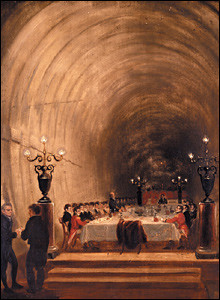 * Ok, I should probably explain the “banquet hall” bit. During the construction of the tunnel there were a couple of big floods. After the first, smaller flood, investors needed some reassurance about the feasibility of the project, so Marc Brunel arranged a banquet in the pumped-out, dried out tunnel itself.
* Ok, I should probably explain the “banquet hall” bit. During the construction of the tunnel there were a couple of big floods. After the first, smaller flood, investors needed some reassurance about the feasibility of the project, so Marc Brunel arranged a banquet in the pumped-out, dried out tunnel itself.
“In the western archway, draped in crimson, a long table was covered in white damask and elaborately set with silver and crystal for a sumptuous banquet. Fifty selected guests, lit by decorative candelabra from the Portable Gas Company, dined while the uniformed band of the Coldstream Guards played the National Anthem, Rule Britannia and See the Conquering Hero Comes.”
(from “The Brunel’s Tunnel”, my £5 bargain.)
"Open House London celebrates all that is best about the capital’s buildings, places and neighbourhoods. Every September, it gives a unique opportunity to get out and under the skin of London’s amazing architecture, with over 700 buildings of all kinds opening their doors to everyone – all for free."What this means is that all over the city buildings that are normally closed to the public open their doors and welcome people in for a look behind the scenes. This could be somewhere as grand and monumental as the Bank of England or as small and quirky as a brand new eco-friendly residential house just down the street. They say it's free which is technically true, except that you really need the guide book to figure things out. The printed-and-mailed dead tree version of the guidebook was £6.50, but the downloadable PDF was only £3.50, arrived instantly, and was pretty friendly on the old iPad, making me feel very au courant. There was even an iPad app for $4.99, which might have been even better because I think it had interactive maps so you could fire it up, see where you were standing, and zero in on any Open House sites nearby. Perhaps next year...
Some of the site are very popular and require you to pre-book to hold a space when the program becomes available in early August. Because I was late to the party this year I was shut out of anything that required pre-booking, which meant my options narrowed a bit, though not a lot because as mentioned above, there were more than 700 sites. I eventually whittled down my choices and on a sunny Saturday morning I set out on the tube, leaving the bike behind to avoid a repeat of my continuing bike locking woes. I hit quite a few sites over the weekend because though I made certain plans I also stayed flexible, meaning that if I unexpectedly happened on the welcoming green Open House poster as I was on my way from point A to point B I was free to veer off to investigate point C. Some point Cs were places where I just poked my head in before deciding they weren't for me, and some were perfectly excellent. For the purposes of this blog post we shall concentrate on the excellent, glossing over the so-so. (There was, for instance, the archeological remains of the western gate of the Roman wall around the city, which were situated in a damp, locked, unmarked room that was part of an underground parking lot. That was only so-so, mostly because though the site was significant, there really wasn't much to see beyond a pile of rocks in the vague shape of a wall. Also, the whole place smelled of exhaust and gasoline. And there was the aforementioned Bank of England, which I skipped because the queue was around the block.) Instead, let's talk about a couple of the hits:
St. Botolph's Aldgate Bells and Belfry:
My first stop on that sunny Saturday morning was to see the bells and belfry of St. Botolph's without Aldgate church (as distinct from St. Botolph's Aldersgate church, which astute GSWPL readers will remember from my blog about Postman's Park). The Open House program promised a visit to the belfry itself and a demonstration of bell ringing, which it turns out is a lot more complicated than just yanking on a bit of rope.
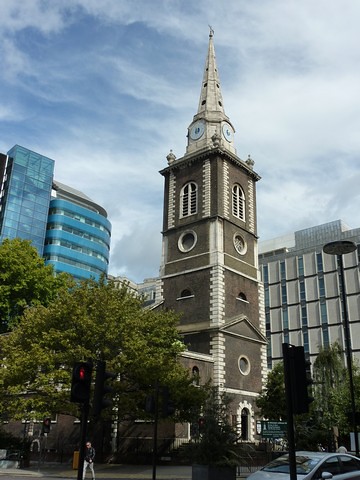 |
| St. Botolph's |

There was a gentleman there from the church's band of bell ringers who gave us some interesting facts about the bells and the craft. There are eight bells at St. Botolph's, which are normally rung in the change ringing style, meaning that a group of ringers will ring each bell in a sequence which changes as they go along. In order to be able to ring in such a controlled fashion, the bells are each hung in a rotating frame that's essentially like a giant pulley with the bell fixed inside it, upside-down. The ringer pulls on the rope, which runs in a channel along the outside of this giant pulley, thus rotating the bell down and back up the other way, almost 360 degrees. Along the way the bell's clapper strikes the side of the bell. The art of bell-ringing is in being able to time that strike to happen exactly on cue, even though the action of pulling the rope is separated by a second or two from the action of the clapper striking. Apparently it takes about six weeks before a novice bell ringer can reliably be expected to be able to, as the local ringer put it "make the bell go dong". And that's just the beginning.
The real art comes in ringing the changes. This means that instead of simply ringing the bells from highest to lowest (1,2,3,4,5,6,7,8), they vary things by changing the order in which they ring according to a series of mathematical patterns which I will not attempt to explain because the charts they had hung up in the ringing room looked to the uninitiated like either 1) meaningless columns of numbers with coloured diagonal lines crossing through them or 2) a EEG with numbers written on it in apparently random places. The guy kept saying that it was all quite simple and all a ringer had to do was concentrate on his little bit of the puzzle and know where in the order he was without having to keep track of the whole thing. I am not buying it.
A video of ringing at St. Botolph’s. (Sadly, this is not MY video of ringing at St. Botolph’s because I continue to be completely flummoxed by actually getting any of my videos to upload successfully to Blogger or Flickr or Youtube, which is starting to really piss me off. Any technical assistance would be appreciated.)
Hung around the ringing room were plaques commemorating the completion of what they call a "full peal" meaning that the ringers successfully completed every possible permutation of ringing eight bells in a different order (5,040 for those keeping track). A full peal is a bit like the marathon of the bell ringing world - it takes about 3-4 hours to complete one and you get no breaks once the peal has started. Also, if anyone screws up the peal is ruined and you have to just stop, give up, and go down to the pub to drown your sorrows. This means that full peals are only attempted rarely and on special occasions like the Queen's Jubilee or the appointment of a new rector at the church. I suspect that the ringing of a full peal is a bit of an event in the neighbourhood as well, since listening to ringing church bells is lovely for a few minutes on a Sunday, but for three and a half hours might start to be classed as tedious and possibly even unsociable.
The eight bells of St. Botolph's range from the treble bell, (the name for the smallest one) to the tenor bell, which weighs in at 1.25 tonnes. All were cast at the Whitechapel Bell Foundry, which is just down the road from the church and one of only two bell foundries remaining in England. The foundry really deserves a blog post all it's own, since it was established in 1570 and is therefore the oldest manufacturing company in Britain. They cast the Liberty Bell and Big Ben! (And they do tours on selected Saturdays, though I think they fill up fast.) I even got to see that actual Whitechapel Foundry bells at the end of the ringing demonstration, when they took people up in small groups to see the belfry itself.
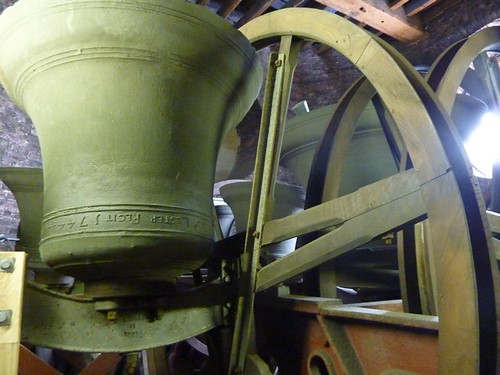 |
| The treble bell, positioned in its upside-down ready-to-ring state. Note the writing on the side indicating that the bell was cast in 1744. |
The Grand Entrance Hall to Brunel’s Tunnel under the Thames:
This was a site I discovered when I realised that the index of the Open House Program had a whole section devoted to industrial sites like pumping stations, distilleries, engine houses and even the Royal Small Arms Factory. Naturally, being something of an engineering geek, I was immediately taken with the description accompanying the entry for the Brunel Museum:
“Guided descents of subterranean chamber half the size of Shakespeare’s Globe. Self guided train tours of Thames Tunnel, one time shopping arcade, banquet hall and fairground. Award winning river gardens.”Subterranean chambers? Shopping arcade? Banquet Hall*? It all sounded worth a visit, even though it meant another trip to the dreaded Canada Water – far flung home of the bike shop I’ve visited too many times. Off I went. (And now, while I make my way out to Canada Water, a little back story on the Thames Tunnel and the brilliant Brunels, pere and fils.)
By the early 19th century shipping traffic on the Thames had increased to such a volume that unloading ships sometimes had to wait months for a space to open at a dock so they could unload their cargo. Once cargo was finally unloaded it could only cross the river on small ferry boats or by means of the two nearest bridges – London Bridge and Blackfriars Bridge. London Bridge was closest to the docks, but so congested that it could take days to cross. An alternative crossing downstream of London Bridge was desperately needed, but any bridge would have to allow tall-masted shipping traffic through, and these were the days before steam engines were powerful enough to raise bascules like those of Tower Bridge. (Remember Tower Bridge was not opened until 1894.)
Enter Marc Brunel: French-born engineering genius who is probably best know for siring his much more famous engineering genius son, the fantastically named Isambard Kingdom Brunel. Brunel Sr. decided that a tunnel across the Thames was the way forward, despite the fact that the ground under the river was notoriously soft and difficult to dig, giving rise to the problem of the river impertinently pouring itself into any previously attempted excavations. In order to make it possible to tunnel in soft ground, Brunel invented the tunneling shield, whose basic principle is still in use today. His son Isambard, despite being merely 19 years old, actually supervised the work on the tunnel from 1826 to 1828, when a catastrophic flood of the partially completed tunnel injured him seriously, and forced him to leave the project.
The whole story of the tunnel is of course much more complicated and interesting than I can go into here without causing your coffee to go cold while you’re reading (even though it’s already probably decidedly tepid), so on to the aforementioned “subterranean chamber”. This turned out to be what was once the Grand Entrance Hall to the south end of the completed Thames Tunnel. It’s actually a large round brick structure that was built above ground and allowed to settle into the earth until it was low enough to become the start of the tunnel. It was once beautifully finished with sweeping curved staircases winding around the interior walls to allow the great and the good to access the tunnel.
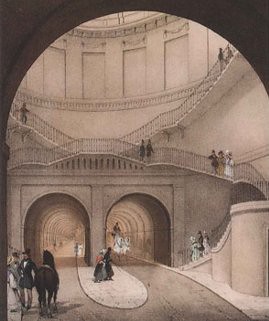 |
| The entrance to the tunnel when it was opened. |
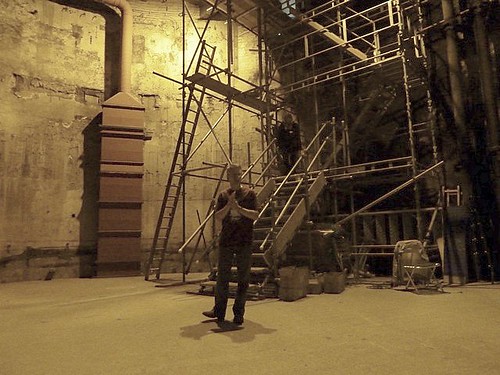 |
| The “Grand Entrance Hall” today. |
Still, I found the Brunel Museum quite plucky and charming, and even bought their little book about the Brunel’s and their tunnel (a mere £5, including an introduction by Michael Palin!). They don’t have a lot going from them the poor Brunel Museum folks. The location is not exactly central, and their big reason for being – the tunnel itself – is actually impossible to see properly. The building the museum is in is the old engine house, and it’s small and a bit rough around the edges. But they manage, and have some nice displays about the history, construction and opening of the tunnel. And they have a good display of books for sale beyond just the one I bought, and they do actually have a lovely patio garden and a tea shop with nice looking proper cakes.
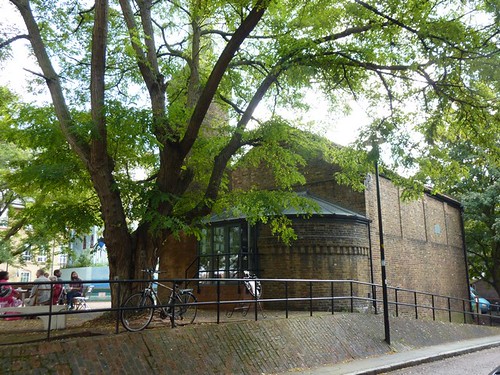 |
| See? It’s a nice spot on a sunny Sunday. |
 * Ok, I should probably explain the “banquet hall” bit. During the construction of the tunnel there were a couple of big floods. After the first, smaller flood, investors needed some reassurance about the feasibility of the project, so Marc Brunel arranged a banquet in the pumped-out, dried out tunnel itself.
* Ok, I should probably explain the “banquet hall” bit. During the construction of the tunnel there were a couple of big floods. After the first, smaller flood, investors needed some reassurance about the feasibility of the project, so Marc Brunel arranged a banquet in the pumped-out, dried out tunnel itself. “In the western archway, draped in crimson, a long table was covered in white damask and elaborately set with silver and crystal for a sumptuous banquet. Fifty selected guests, lit by decorative candelabra from the Portable Gas Company, dined while the uniformed band of the Coldstream Guards played the National Anthem, Rule Britannia and See the Conquering Hero Comes.”
(from “The Brunel’s Tunnel”, my £5 bargain.)



1 Comment:
Thought I'd just mention I'm staying at Brunel Manor, Torquay soon- but this Brunel was Isambard. It was to have been his home but, although he never lived in it, he helped design the formal gardens and the house retains some of his original design. Of course, he is better known for the railway bridge parallel to the Tamar Bridge, linking Cornwall & Devon. A x
Post a Comment